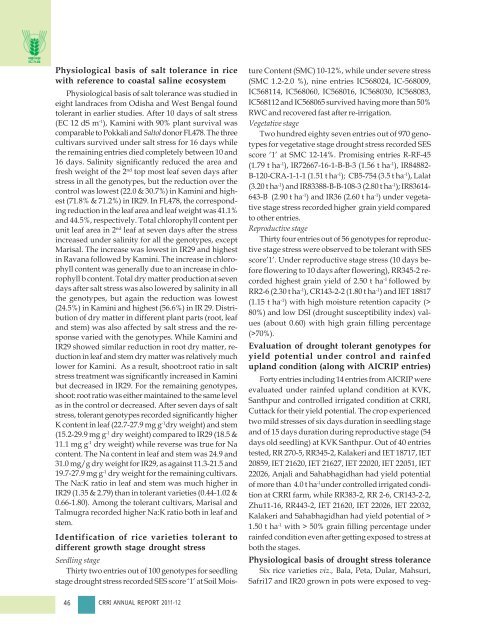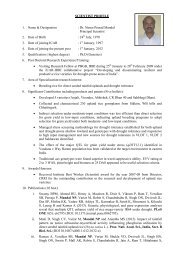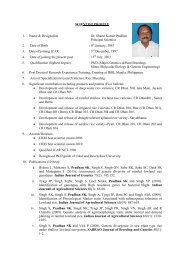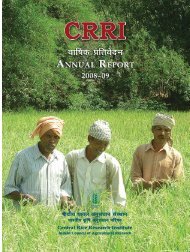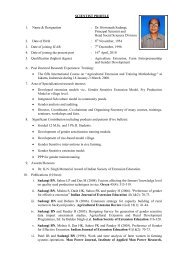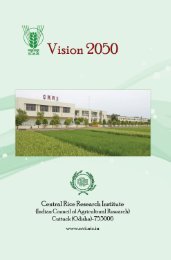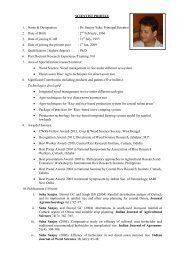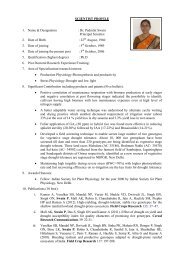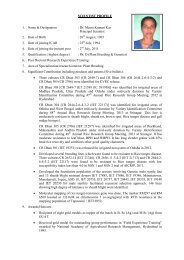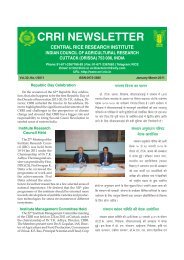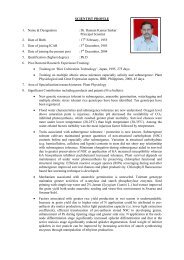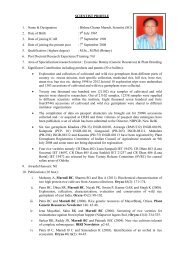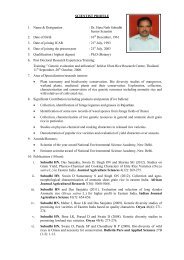Central Rice Research Institute Annual report...2011-12
Central Rice Research Institute Annual report...2011-12
Central Rice Research Institute Annual report...2011-12
You also want an ePaper? Increase the reach of your titles
YUMPU automatically turns print PDFs into web optimized ePapers that Google loves.
Physiological basis of salt tolerance in rice<br />
with reference to coastal saline ecosystem<br />
Physiological basis of salt tolerance was studied in<br />
eight landraces from Odisha and West Bengal found<br />
tolerant in earlier studies. After 10 days of salt stress<br />
(EC <strong>12</strong> dS m -1 ), Kamini with 90% plant survival was<br />
comparable to Pokkali and Saltol donor FL478. The three<br />
cultivars survived under salt stress for 16 days while<br />
the remaining entries died completely between 10 and<br />
16 days. Salinity significantly reduced the area and<br />
fresh weight of the 2 nd top most leaf seven days after<br />
stress in all the genotypes, but the reduction over the<br />
control was lowest (22.0 & 30.7%) in Kamini and highest<br />
(71.8% & 71.2%) in IR29. In FL478, the corresponding<br />
reduction in the leaf area and leaf weight was 41.1%<br />
and 44.5%, respectively. Total chlorophyll content per<br />
unit leaf area in 2 nd leaf at seven days after the stress<br />
increased under salinity for all the genotypes, except<br />
Marisal. The increase was lowest in IR29 and highest<br />
in Ravana followed by Kamini. The increase in chlorophyll<br />
content was generally due to an increase in chlorophyll<br />
b content. Total dry matter production at seven<br />
days after salt stress was also lowered by salinity in all<br />
the genotypes, but again the reduction was lowest<br />
(24.5%) in Kamini and highest (56.6%) in IR 29. Distribution<br />
of dry matter in different plant parts (root, leaf<br />
and stem) was also affected by salt stress and the response<br />
varied with the genotypes. While Kamini and<br />
IR29 showed similar reduction in root dry matter, reduction<br />
in leaf and stem dry matter was relatively much<br />
lower for Kamini. As a result, shoot:root ratio in salt<br />
stress treatment was significantly increased in Kamini<br />
but decreased in IR29. For the remaining genotypes,<br />
shoot: root ratio was either maintained to the same level<br />
as in the control or decreased. After seven days of salt<br />
stress, tolerant genotypes recorded significantly higher<br />
K content in leaf (22.7-27.9 mg g -1 dry weight) and stem<br />
(15.2-29.9 mg g -1 dry weight) compared to IR29 (18.5 &<br />
11.1 mg g -1 dry weight) while reverse was true for Na<br />
content. The Na content in leaf and stem was 24.9 and<br />
31.0 mg/g dry weight for IR29, as against 11.3-21.5 and<br />
19.7-27.9 mg g -1 dry weight for the remaining cultivars.<br />
The Na:K ratio in leaf and stem was much higher in<br />
IR29 (1.35 & 2.79) than in tolerant varieties (0.44-1.02 &<br />
0.66-1.80). Among the tolerant cultivars, Marisal and<br />
Talmugra recorded higher Na:K ratio both in leaf and<br />
stem.<br />
Identification of rice varieties tolerant to<br />
different growth stage drought stress<br />
Seedling stage<br />
Thirty two entries out of 100 genotypes for seedling<br />
stage drought stress recorded SES score ‘1’ at Soil Moisture<br />
Content (SMC) 10-<strong>12</strong>%, while under severe stress<br />
(SMC 1.2-2.0 %), nine entries IC568024, IC-568009,<br />
IC568114, IC568060, IC568016, IC568030, IC568083,<br />
IC5681<strong>12</strong> and IC568065 survived having more than 50%<br />
RWC and recovered fast after re-irrigation.<br />
Vegetative stage<br />
Two hundred eighty seven entries out of 970 genotypes<br />
for vegetative stage drought stress recorded SES<br />
score ‘1’ at SMC <strong>12</strong>-14%. Promising entries R-RF-45<br />
(1.79 t ha -1 ), IR72667-16-1-B-B-3 (1.56 t ha -1 ), IR84882-<br />
B-<strong>12</strong>0-CRA-1-1-1 (1.51 t ha -1 ); CB5-754 (3.5 t ha -1 ), Lalat<br />
(3.20 t ha -1 ) and IR83388-B-B-108-3 (2.80 t ha -1 ); IR83614-<br />
643-B (2.90 t ha -1 ) and IR36 (2.60 t ha -1 ) under vegetative<br />
stage stress recorded higher grain yield compared<br />
to other entries.<br />
Reproductive stage<br />
Thirty four entries out of 56 genotypes for reproductive<br />
stage stress were observed to be tolerant with SES<br />
score’1’. Under reproductive stage stress (10 days before<br />
flowering to 10 days after flowering), RR345-2 recorded<br />
highest grain yield of 2.50 t ha -1 followed by<br />
RR2-6 (2.30 t ha -1 ), CR143-2-2 (1.80 t ha -1 ) and IET 18817<br />
(1.15 t ha -1 ) with high moisture retention capacity (><br />
80%) and low DSI (drought susceptibility index) values<br />
(about 0.60) with high grain filling percentage<br />
(>70%).<br />
Evaluation of drought tolerant genotypes for<br />
yield potential under control and rainfed<br />
upland condition (along with AICRIP entries)<br />
Forty entries including 14 entries from AICRIP were<br />
evaluated under rainfed upland condition at KVK,<br />
Santhpur and controlled irrigated condition at CRRI,<br />
Cuttack for their yield potential. The crop experienced<br />
two mild stresses of six days duration in seedling stage<br />
and of 15 days duration during reproductive stage (54<br />
days old seedling) at KVK Santhpur. Out of 40 entries<br />
tested, RR 270-5, RR345-2, Kalakeri and IET 18717, IET<br />
20859, IET 21620, IET 21627, IET 22020, IET 22051, IET<br />
22026, Anjali and Sahabhagidhan had yield potential<br />
of more than 4.0 t ha -1 under controlled irrigated condition<br />
at CRRI farm, while RR383-2, RR 2-6, CR143-2-2,<br />
Zhu11-16, RR443-2, IET 21620, IET 22026, IET 22032,<br />
Kalakeri and Sahabhagidhan had yield potential of ><br />
1.50 t ha -1 with > 50% grain filling percentage under<br />
rainfed condition even after getting exposed to stress at<br />
both the stages.<br />
Physiological basis of drought stress tolerance<br />
Six rice varieties viz., Bala, Peta, Dular, Mahsuri,<br />
Safri17 and IR20 grown in pots were exposed to veg-<br />
46 CRRI ANNUAL REPORT 2011-<strong>12</strong>


